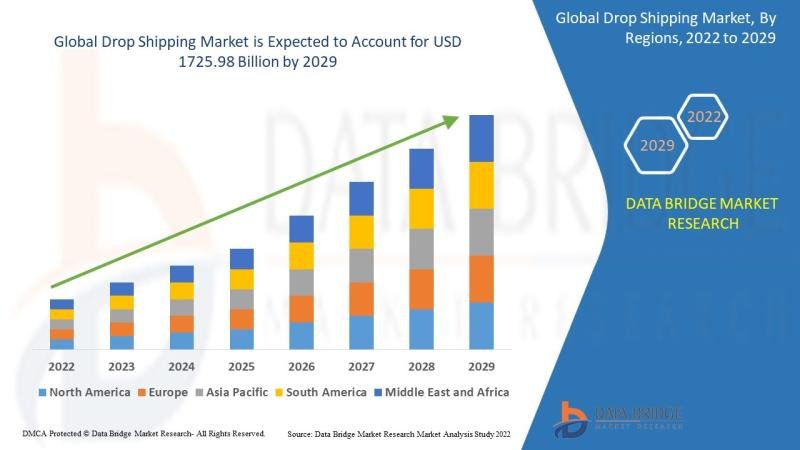
Drop Shipping Market
The drop shipping market has experienced significant growth over recent years, establishing itself as a key component in the global e-commerce ecosystem. This business model, characterized by minimal upfront investment and inventory-free operations, appeals to entrepreneurs and businesses aiming to enter the online retail sector. Below, we explore the drop shipping market through its overview, scope, emerging trends, and influential factors.
Browse More About This Research Report @ https://www.databridgemarketresearch.com/reports/global-drop-shipping-market
Overview of the Drop Shipping Market
Drop shipping is a retail fulfillment method where a store doesn’t keep the products it sells in stock. Instead, when a store sells a product, it purchases the item from a third party-usually a wholesaler or manufacturer-and has it shipped directly to the customer. This eliminates the need for the retailer to handle inventory management, storage, or shipping logistics.
This model’s simplicity and cost-effectiveness have made it a popular choice among small to medium-sized businesses. Established e-commerce platforms such as Shopify, WooCommerce, and BigCommerce have further fueled the growth of drop shipping by offering integrated tools and resources for aspiring retailers.
The Scope of Drop Shipping
The drop shipping market’s scope extends across various industries, encompassing fashion, electronics, home décor, health and beauty, and niche products. Its global nature allows retailers to tap into international markets without requiring physical presence or substantial capital investment.
With the rise of digital marketing, drop shipping businesses can reach a wider audience through social media advertising, search engine optimization, and influencer partnerships. Moreover, the increasing penetration of smartphones and internet services has enabled consumers from even remote areas to engage with online shopping platforms, expanding the potential customer base for drop shipping businesses.
Another significant advantage is the scalability of drop shipping. Businesses can quickly expand their product offerings and geographical reach without incurring additional inventory or storage costs. This flexibility allows retailers to adapt to market demands and consumer preferences swiftly.
Key Market Trends
Several trends are shaping the current landscape of the drop shipping market. These trends indicate both challenges and opportunities for businesses operating within this model:
Integration of AI and Automation:
Advanced technologies such as artificial intelligence (AI) and automation tools are transforming drop shipping operations. AI-powered tools help optimize pricing strategies, predict demand trends, and automate customer service via chatbots, enhancing overall efficiency.
Sustainability and Ethical Sourcing:
Consumers are becoming increasingly conscious of environmental and ethical considerations when making purchases. Drop shipping businesses are responding by offering sustainable products and ensuring transparent sourcing practices.
Personalization:
Personalization has become a crucial differentiator in the e-commerce space. Drop shipping retailers leverage data analytics to tailor recommendations and create customized shopping experiences for their customers.
Mobile Commerce (m-Commerce):
The growing prevalence of mobile commerce continues to drive the drop shipping market forward. Optimizing websites and apps for mobile users is essential for retailers looking to capitalize on this trend.
Niche Markets:
Catering to niche markets has emerged as a successful strategy for drop shipping businesses. By targeting specific customer segments, retailers can build brand loyalty and differentiate themselves from competitors.
Influential Factors in the Drop Shipping Market
Various factors influence the growth and dynamics of the drop shipping market. Understanding these elements is critical for businesses aiming to thrive in this competitive space:
Globalization:
The drop shipping market benefits from globalization, allowing retailers to source products from international suppliers and cater to customers worldwide. However, this also brings challenges such as navigating cross-border regulations and managing shipping times.
Technological Advancements:
Technology plays a pivotal role in enabling drop shipping businesses to operate seamlessly. From inventory management software to customer relationship management (CRM) systems, technological tools are indispensable for efficiency.
Consumer Behavior:
Shifts in consumer behavior significantly impact the drop shipping market. Factors like rising preference for online shopping, demand for convenience, and expectations for fast delivery influence how businesses operate.
Competition:
The low entry barrier in the drop shipping market has led to intense competition. Retailers must focus on building a strong brand identity, offering quality products, and delivering exceptional customer service to stand out.
Economic Conditions:
Economic factors such as disposable income levels, currency exchange rates, and shipping costs affect the profitability and feasibility of drop shipping ventures. Businesses must stay attuned to these variables and adjust their strategies accordingly.
Conclusion
The drop shipping market presents vast opportunities for entrepreneurs and businesses willing to embrace innovation and adapt to changing consumer demands. With its low startup costs, global reach, and scalability, this model continues to attract players from diverse industries. However, success in the drop shipping space requires a strategic approach, leveraging technology, addressing customer expectations, and staying ahead of market trends.
By understanding its scope, keeping an eye on emerging trends, and considering influential factors, businesses can navigate the complexities of the drop shipping market and position themselves for sustainable growth. Whether a seasoned entrepreneur or a newcomer, the potential of drop shipping remains promising in the ever-evolving e-commerce landscape.
Browse Trending Reports:
https://newsasdbmr.blogspot.com/2024/12/textile-fabric-market-size-share-demand.html
https://newsasdbmr.blogspot.com/2024/12/olefins-market-size-share-trends-key.html
https://newsasdbmr.blogspot.com/2024/12/fermenters-market-size-share-trends.html
https://newsasdbmr.blogspot.com/2024/12/agriculture-seeder-market-size-share.html
About Data Bridge Market Research:
An absolute way to predict what the future holds is to understand the current trend! Data Bridge Market Research presented itself as an unconventional and neoteric market research and consulting firm with an unparalleled level of resilience and integrated approaches. We are committed to uncovering the best market opportunities and nurturing effective information for your business to thrive in the marketplace. Data Bridge strives to provide appropriate solutions to complex business challenges and initiates an effortless decision-making process. Data Bridge is a set of pure wisdom and experience that was formulated and framed in 2015 in Pune.
Data Bridge Market Research has more than 500 analysts working in different industries. We have served more than 40% of the Fortune 500 companies globally and have a network of more than 5,000 clients worldwide. Data Bridge is an expert in creating satisfied customers who trust our services and trust our hard work with certainty. We are pleased with our glorious 99.9% customer satisfaction rating.
Contact Us: –
Data Bridge Market Research
US: +1 888 387 2818
United Kingdom: +44 208 089 1725
Hong Kong: +852 8192 7475
Email: – sopan.gedam@databridgemarketresearch.com
This release was published on openPR.
The drop shipping market has experienced significant growth over recent years, establishing itself as a key component in the global e-commerce ecosystem. This business model, characterized by minimal upfront investment and inventory-free operations, appeals to entrepreneurs and businesses aiming to enter the online retail sector. Below, we explore the drop shipping market through its overview, scope, emerging trends, and influential factors.
Browse More About This Research Report @ https://www.databridgemarketresearch.com/reports/global-drop-shipping-market
Overview of the Drop Shipping Market
Drop shipping is a retail fulfillment method where a store doesn’t keep the products it sells in stock. Instead, when a store sells a product, it purchases the item from a third party-usually a wholesaler or manufacturer-and has it shipped directly to the customer. This eliminates the need for the retailer to handle inventory management, storage, or shipping logistics.
This model’s simplicity and cost-effectiveness have made it a popular choice among small to medium-sized businesses. Established e-commerce platforms such as Shopify, WooCommerce, and BigCommerce have further fueled the growth of drop shipping by offering integrated tools and resources for aspiring retailers.
The Scope of Drop Shipping
The drop shipping market’s scope extends across various industries, encompassing fashion, electronics, home décor, health and beauty, and niche products. Its global nature allows retailers to tap into international markets without requiring physical presence or substantial capital investment.
With the rise of digital marketing, drop shipping businesses can reach a wider audience through social media advertising, search engine optimization, and influencer partnerships. Moreover, the increasing penetration of smartphones and internet services has enabled consumers from even remote areas to engage with online shopping platforms, expanding the potential customer base for drop shipping businesses.
Another significant advantage is the scalability of drop shipping. Businesses can quickly expand their product offerings and geographical reach without incurring additional inventory or storage costs. This flexibility allows retailers to adapt to market demands and consumer preferences swiftly.
Key Market Trends
Several trends are shaping the current landscape of the drop shipping market. These trends indicate both challenges and opportunities for businesses operating within this model:
Integration of AI and Automation:
Advanced technologies such as artificial intelligence (AI) and automation tools are transforming drop shipping operations. AI-powered tools help optimize pricing strategies, predict demand trends, and automate customer service via chatbots, enhancing overall efficiency.
Sustainability and Ethical Sourcing:
Consumers are becoming increasingly conscious of environmental and ethical considerations when making purchases. Drop shipping businesses are responding by offering sustainable products and ensuring transparent sourcing practices.
Personalization:
Personalization has become a crucial differentiator in the e-commerce space. Drop shipping retailers leverage data analytics to tailor recommendations and create customized shopping experiences for their customers.
Mobile Commerce (m-Commerce):
The growing prevalence of mobile commerce continues to drive the drop shipping market forward. Optimizing websites and apps for mobile users is essential for retailers looking to capitalize on this trend.
Niche Markets:
Catering to niche markets has emerged as a successful strategy for drop shipping businesses. By targeting specific customer segments, retailers can build brand loyalty and differentiate themselves from competitors.
Influential Factors in the Drop Shipping Market
Various factors influence the growth and dynamics of the drop shipping market. Understanding these elements is critical for businesses aiming to thrive in this competitive space:
Globalization:
The drop shipping market benefits from globalization, allowing retailers to source products from international suppliers and cater to customers worldwide. However, this also brings challenges such as navigating cross-border regulations and managing shipping times.
Technological Advancements:
Technology plays a pivotal role in enabling drop shipping businesses to operate seamlessly. From inventory management software to customer relationship management (CRM) systems, technological tools are indispensable for efficiency.
Consumer Behavior:
Shifts in consumer behavior significantly impact the drop shipping market. Factors like rising preference for online shopping, demand for convenience, and expectations for fast delivery influence how businesses operate.
Competition:
The low entry barrier in the drop shipping market has led to intense competition. Retailers must focus on building a strong brand identity, offering quality products, and delivering exceptional customer service to stand out.
Economic Conditions:
Economic factors such as disposable income levels, currency exchange rates, and shipping costs affect the profitability and feasibility of drop shipping ventures. Businesses must stay attuned to these variables and adjust their strategies accordingly.
Conclusion
The drop shipping market presents vast opportunities for entrepreneurs and businesses willing to embrace innovation and adapt to changing consumer demands. With its low startup costs, global reach, and scalability, this model continues to attract players from diverse industries. However, success in the drop shipping space requires a strategic approach, leveraging technology, addressing customer expectations, and staying ahead of market trends.
By understanding its scope, keeping an eye on emerging trends, and considering influential factors, businesses can navigate the complexities of the drop shipping market and position themselves for sustainable growth. Whether a seasoned entrepreneur or a newcomer, the potential of drop shipping remains promising in the ever-evolving e-commerce landscape.
Browse Trending Reports:
https://newsasdbmr.blogspot.com/2024/12/textile-fabric-market-size-share-demand.html
https://newsasdbmr.blogspot.com/2024/12/olefins-market-size-share-trends-key.html
https://newsasdbmr.blogspot.com/2024/12/fermenters-market-size-share-trends.html
https://newsasdbmr.blogspot.com/2024/12/agriculture-seeder-market-size-share.html
About Data Bridge Market Research:
An absolute way to predict what the future holds is to understand the current trend! Data Bridge Market Research presented itself as an unconventional and neoteric market research and consulting firm with an unparalleled level of resilience and integrated approaches. We are committed to uncovering the best market opportunities and nurturing effective information for your business to thrive in the marketplace. Data Bridge strives to provide appropriate solutions to complex business challenges and initiates an effortless decision-making process. Data Bridge is a set of pure wisdom and experience that was formulated and framed in 2015 in Pune.
Data Bridge Market Research has more than 500 analysts working in different industries. We have served more than 40% of the Fortune 500 companies globally and have a network of more than 5,000 clients worldwide. Data Bridge is an expert in creating satisfied customers who trust our services and trust our hard work with certainty. We are pleased with our glorious 99.9% customer satisfaction rating.
Contact Us: –
Data Bridge Market Research
US: +1 888 387 2818
United Kingdom: +44 208 089 1725
Hong Kong: +852 8192 7475
Email: – sopan.gedam@databridgemarketresearch.com
This release was published on openPR.





















































































buy clomid no prescription where buy cheap clomiphene price can i purchase generic clomiphene for sale where to buy cheap clomid how to buy cheap clomiphene can you buy cheap clomid online clomiphene medication cost
I will immediately take hold of your rss feed as I can’t find your email subscription link or newsletter service. Do you’ve any? Kindly permit me understand so that I could subscribe. Thanks.
Thanks on putting this up. It’s well done.
More articles like this would pretence of the blogosphere richer.
buy azithromycin 500mg without prescription – buy ciplox 500mg pills flagyl 200mg generic
rybelsus 14mg brand – cyproheptadine for sale online order periactin 4 mg sale
domperidone generic – domperidone 10mg over the counter where to buy flexeril without a prescription
purchase inderal without prescription – order methotrexate for sale oral methotrexate 5mg
cost amoxicillin – ipratropium brand buy combivent
zithromax 500mg cost – order nebivolol 20mg without prescription buy bystolic 20mg generic
incrível este conteúdo. Gostei muito. Aproveitem e vejam este conteúdo. informações, novidades e muito mais. Não deixem de acessar para descobrir mais. Obrigado a todos e até mais. 🙂
Este site é realmente fascinate. Sempre que acesso eu encontro coisas incríveis Você também pode acessar o nosso site e saber mais detalhes! conteúdo único. Venha saber mais agora! 🙂
buy clavulanate tablets – atbioinfo acillin tablet
esomeprazole 20mg for sale – anexa mate nexium 40mg capsules
coumadin over the counter – blood thinner purchase losartan sale
Some genuinely good posts on this web site, appreciate it for contribution. “Give me the splendid silent sun with all his beams full-dazzling.” by Walt Whitman.
buy mobic 15mg pill – https://moboxsin.com/ cost meloxicam 7.5mg
buy prednisone 20mg pill – apreplson.com cheap prednisone
buy ed pills online – fast ed to take erection pills online
order amoxicillin pill – https://combamoxi.com/ buy generic amoxil for sale
buy fluconazole 200mg online – https://gpdifluca.com/ buy fluconazole 100mg generic
cenforce price – https://cenforcers.com/ order cenforce
comprar tadalafil 40 mg en walmart sin receta houston texas – https://ciltadgn.com/# cialis as generic
cialis and poppers – https://strongtadafl.com/ safest and most reliable pharmacy to buy cialis
buy zantac 300mg sale – https://aranitidine.com/# buy ranitidine medication
buy in real viagra – strong vpls can you buy viagra cvs
This is the kind of enter I turn up helpful. buy nolvadex generic
The thoroughness in this piece is noteworthy. natural alternative to prednisone
This is the kind of content I have reading. https://ursxdol.com/prednisone-5mg-tablets/
This is the kind of enter I turn up helpful. https://prohnrg.com/product/priligy-dapoxetine-pills/
Very great post. I simply stumbled upon your blog and wished to say that I have truly loved browsing your blog posts. After all I’ll be subscribing to your feed and I’m hoping you write once more soon!
This is a question which is virtually to my verve… Diverse thanks! Unerringly where can I lay one’s hands on the phone details an eye to questions? https://aranitidine.com/fr/cialis-super-active/
More posts like this would make the blogosphere more useful. https://ondactone.com/simvastatin/
With thanks. Loads of conception!
https://proisotrepl.com/product/toradol/
Just desire to say your article is as amazing. The clarity for your put up is simply excellent and that i could suppose you are a professional on this subject. Fine along with your permission let me to grab your RSS feed to stay up to date with approaching post. Thanks a million and please keep up the rewarding work.
This is a question which is near to my verve… Myriad thanks! Quite where can I lay one’s hands on the connection details due to the fact that questions? http://www.orlandogamers.org/forum/member.php?action=profile&uid=29106
I wanted to thank you for this great read!! I definitely enjoying every little bit of it I have you bookmarked to check out new stuff you post…
buy dapagliflozin pills for sale – click buy generic dapagliflozin online
generic orlistat – click buy xenical 60mg for sale
I’ll certainly bring to read more. http://mi.minfish.com/home.php?mod=space&uid=1421050